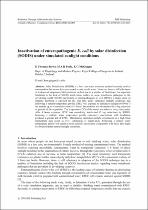 ResearchSpace
ResearchSpace
Inactivation of enteropathogenic E. coli by solar disinfection (SODIS) under simulated sunlight conditions
JavaScript is disabled for your browser. Some features of this site may not work without it.
- ResearchSpace
- →
- Research Publications/Outputs
- →
- Conference Publications
- →
- View Item
| dc.contributor.author |
Ubomba-Jaswa, Eunice

|
|
| dc.contributor.author |
Boyle, MAR

|
|
| dc.contributor.author |
McGuigan, KG

|
|
| dc.date.accessioned | 2009-09-29T12:51:04Z | |
| dc.date.available | 2009-09-29T12:51:04Z | |
| dc.date.issued | 2008-12 | |
| dc.identifier.citation | Ubomba-Jaswa, E, Boyle, MAR and McGuigan, KG. 2008. Inactivation of enteropathogenic E. coli by solar disinfection (SODIS) under simulated sunlight conditions. Journal of Physics: Conference Series, Vol. 101, pp 1-4 | en |
| dc.identifier.issn | 1742-6596 | |
| dc.identifier.uri | http://iopscience.iop.org/1742-6596/101/1/012003/pdf?ejredirect=.iopscience | |
| dc.identifier.uri | http://hdl.handle.net/10204/3626 | |
| dc.description | Copyright: 2008 IOP Publishing | en |
| dc.description.abstract | Solar Disinfection (SODIS) is a low cost water treatment method currently used in communities that do not have year round access to safe water. However, there is still reluctance in widespread adoption of this treatment method due to a number of limitations. An important limitation is the lack of SODIS inactivation studies on some waterborne pathogens in the developing world. SODIS inactivation of enteropathogenic E. coli (EPEC), a major cause of infantile diarrhoea is reported for the first time under simulated sunlight conditions and following a natural temperature profile. EPEC was exposed to simulated sunlight (885Wm-2) or periods up to a cumulative time of 4 hours. Inactivation was determined by a log reduction in growth of the organisms. The temperature (oC) of the water was taken at every time point. After 4 hours exposure EPEC was completely inactivated (7 log reduction) by SODIS. Imposing a realistic water temperature profile (min-max) concomitant with irradiation produces a greater kill of EPEC. Maintaining simulated sunlight experiments at a high fixed temperature may result in over-estimation of inactivation. Following a natural water temperature profile will result in more reliable inactivation comparable with those that might be obtained under natural sunlight conditions. | en |
| dc.language.iso | en | en |
| dc.publisher | IOP Publishing | en |
| dc.subject | Enteropathogenic E.coli | en |
| dc.subject | Solar disinfection simulated sunlight | en |
| dc.subject | SODIS | en |
| dc.subject | Radiation damage | en |
| dc.subject | Biomolecular systems | en |
| dc.subject | Physics | en |
| dc.subject | Safe water | en |
| dc.title | Inactivation of enteropathogenic E. coli by solar disinfection (SODIS) under simulated sunlight conditions | en |
| dc.type | Conference Presentation | en |
| dc.identifier.apacitation | Ubomba-Jaswa, E., Boyle, M., & McGuigan, K. (2008). Inactivation of enteropathogenic E. coli by solar disinfection (SODIS) under simulated sunlight conditions. IOP Publishing. http://hdl.handle.net/10204/3626 | en_ZA |
| dc.identifier.chicagocitation | Ubomba-Jaswa, Eunice, MAR Boyle, and KG McGuigan. "Inactivation of enteropathogenic E. coli by solar disinfection (SODIS) under simulated sunlight conditions." (2008): http://hdl.handle.net/10204/3626 | en_ZA |
| dc.identifier.vancouvercitation | Ubomba-Jaswa E, Boyle M, McGuigan K, Inactivation of enteropathogenic E. coli by solar disinfection (SODIS) under simulated sunlight conditions; IOP Publishing; 2008. http://hdl.handle.net/10204/3626 . | en_ZA |
| dc.identifier.ris | TY - Conference Presentation AU - Ubomba-Jaswa, Eunice AU - Boyle, MAR AU - McGuigan, KG AB - Solar Disinfection (SODIS) is a low cost water treatment method currently used in communities that do not have year round access to safe water. However, there is still reluctance in widespread adoption of this treatment method due to a number of limitations. An important limitation is the lack of SODIS inactivation studies on some waterborne pathogens in the developing world. SODIS inactivation of enteropathogenic E. coli (EPEC), a major cause of infantile diarrhoea is reported for the first time under simulated sunlight conditions and following a natural temperature profile. EPEC was exposed to simulated sunlight (885Wm-2) or periods up to a cumulative time of 4 hours. Inactivation was determined by a log reduction in growth of the organisms. The temperature (oC) of the water was taken at every time point. After 4 hours exposure EPEC was completely inactivated (7 log reduction) by SODIS. Imposing a realistic water temperature profile (min-max) concomitant with irradiation produces a greater kill of EPEC. Maintaining simulated sunlight experiments at a high fixed temperature may result in over-estimation of inactivation. Following a natural water temperature profile will result in more reliable inactivation comparable with those that might be obtained under natural sunlight conditions. DA - 2008-12 DB - ResearchSpace DP - CSIR KW - Enteropathogenic E.coli KW - Solar disinfection simulated sunlight KW - SODIS KW - Radiation damage KW - Biomolecular systems KW - Physics KW - Safe water LK - https://researchspace.csir.co.za PY - 2008 SM - 1742-6596 T1 - Inactivation of enteropathogenic E. coli by solar disinfection (SODIS) under simulated sunlight conditions TI - Inactivation of enteropathogenic E. coli by solar disinfection (SODIS) under simulated sunlight conditions UR - http://hdl.handle.net/10204/3626 ER - | en_ZA |





